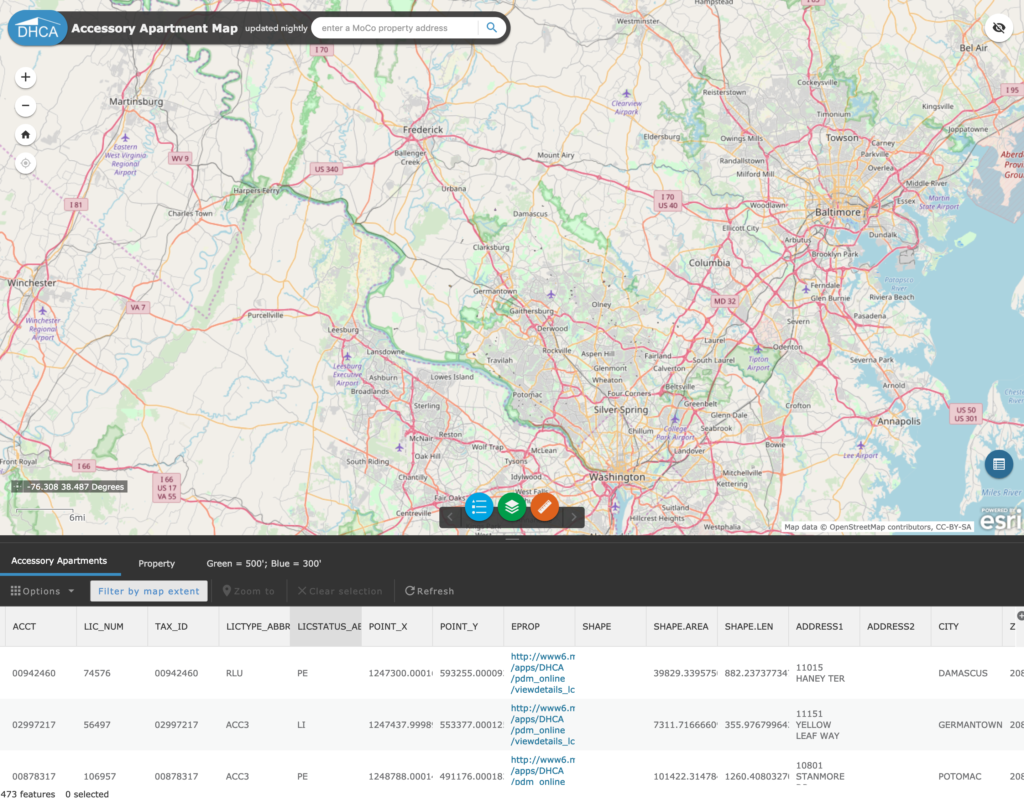Councilmember Hans Riemer’s proposal to greatly ease restrictions on accessory dwelling units (ADUs) has a lot of flaws, as I have detailed in previous posts. The presentation of inaccurate information also undermines confidence that it has been well thought out. The county’s very poor enforcement of existing housing law further reduces trust. Moreover, recent legislation designed to promote ADU construction is just now going into effect.
Fortunately, two easy fixes to Hans’s proposal can assure that it will better accomplish his stated goals of increasing smart-growth oriented affordable housing and minimize any negative effects on the county finances and residents.
Fix #1: Locate ADUs Near Transit
The county wants to promote transit-oriented growth so let’s limit ADUs to within a three-quarters mile radius of Metro, MARC, and future Purple Line stations. As one can rarely walk directly in a straight line to transit from a single-family neighborhood, a three-quarter mile radius is really greater in terms of travel distance and provides a very generous zone. (This would include my Metro-walkable single-family neighborhood.)
The bus network is also largely oriented towards these nodes, so people living in these areas will have maximal public transit access. Transit accessibility will also likely reduce the share of ADU residents who have cars, or at least a second car. This simple fix will assure that we continue to promote growth where smart growthers claim to want it—away from car dependent neighborhoods.
Fix #2: Reduce, Rather than Increase, ADU Size
Hans’s zoning text amendment (ZTA) proposes to allow ADUs larger than the current 1200 square foot maximum up to the one-half of the size of main home. This is a disastrous idea as it encourages the construction of larger, and therefore less affordable units. It also incentivizes the construction of bigger homes, which also runs counter to the idea of smart growth.
While Hans has repeatedly spoken about his ZTA in terms of promoting “cottages” and as part of the “tiny house movement,” the legislation runs directly counter to this idea. According to The Tiny Life, a publication promoting tiny homes, tiny homes have a maximum of 400 square feet, and the average tiny home has just 186 square feet.
At 1200 square feet, Montgomery’s current limit is already three times the maximum size for a tiny home and over six times the average tiny home size. (Scouring the web, the most generous maximum for a tiny home was 600 but this was on a builders’ website and is still only one-half of what the county already permits.)
Instead of increasing the size limit and encouraging the construction of less affordable ADUs, we should be reducing it to 750 square feet. This smaller size would assure that new ADUs would be truly fit within the affordable, smaller home ideal, instead of large second homes or apartments out of the range of people struggling to find housing.
Additionally, it will minimize any negative impacts on neighborhoods and the county. Smaller homes mean it’s less likely that schools will face as substantial an additional burden as if we amp up the home size instead. Fewer people also usually means fewer cars. Existing units larger than 750 square feet would be grandfathered.
The smaller size also reduces any additional hardscape, especially important since the chance of the county adopting more meaningful storm water control standards is about nil. Smaller homes cut down the added burden on existing aging infrastructure not to mention on dumping water into neighboring basements.
Bottom Line: Make this an Affordable Housing Bill
These changes to Hans’s ZTA would turn it from a bill that undermines affordable housing by incentivizing big into one that would encourage the building of smaller, more affordable units in transit-accessible areas. It would retain the proposed elimination on the construction of an ADU in close proximity to another one, allowing for substantially more construction in zones near transit.
As bill proponents claim loudly that they are promoting small development and favor smart growth, adopting these amendments to gather community support ought to be easy. A special exception process could be included to accommodate unusual circumstances that require more space or location away from transit. But any such process should require real scrutiny and difficulty in order to keep the focus on affordable.
The bottom line is that adopting these changes would turn the bill into one truly focused on transit-oriented affordable housing and a genuine win for Hans. On the other hand, if self-proclaimed proponents of affordable housing continue to argue for larger rather than smaller units, it will reveal plainly that they are simply interested in promoting development rather than affordable and that this is really an effort to undermine recently adopted zoning codes and Master Plans.

